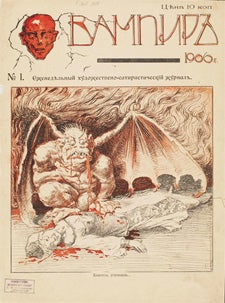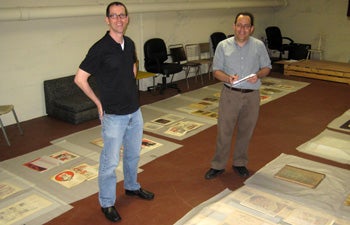Illustrated Evils
A winged vampire feeds on a girl’s lifeless body. A skeleton dressed in a black cape and epaulettes juggles a knife, two pistols and a cannon ball. A woman holding a red flag emblazoned with the word svoboda (“freedom”) faces a circle of soldiers with their bayonets drawn.
These are just a few of the provocative images from a collection of Russian satirical journals featured in the new USC Libraries exhibition “Demonocracy: All Hell Breaks Loose in 1905 Russia.”
The collection of approximately 600 journals, produced during the revolutionary upheaval of 1905 to 1907, is from the Institute of Modern Russian Culture (IMRC) housed in USC Dornsife.
According to Marcus Levitt, associate professor of Slavic languages and literatures and the exhibition’s principal investigator, the journals present a portrait of one of the most exhilarating and provocative episodes in Russia’s political, social and cultural history.
Beginning in 1905, strikes, protests and mutinies spread across Russia and challenged the power of Tsar Nicholas II. Artists and journalists of the time created a multitude of popular satirical publications that envisioned the revolutionary events as a nightmare of devils, vampires, monsters, skeletons, executions, anti-Semitic pogroms, rapes and assassinations.
This issue of Bureval (Storm Debris) was published in March 1906 in St. Petersburg.
Printed mostly in bold red and black, the journal illustrations seem to leap off the pages, embodying the sense of freedom shared by the Russian press, which no longer had to submit its publications to censors for review in the wake of the 1905 October Manifesto.
That freedom was short-lived, however. The majority of the journals, and many that comprise the exhibition, were officially banned upon their release. Journalists and artists were arrested and put on trial for offenses such as using cartoons to insult the Tsar. Press regulations increased to become harsher than they had been prior to 1905.

One of the many Russian satirical journals in the collection from the Institute of Modern Russian Culture (IMRC).
“The journals serve as a record of the birth of party politics in Russia; evidence of the development of graphic art; a chapter in the history of Russian journalism, censorship and the press; and a showcase for demonology and its relationship to satire and political discourse,” Levitt said.
In addition to serving as an emotional snapshot of a time period, the journals are a microcosm of contemporary literary and artistic trends, and feature works by some of the best artists, writers and journalists of the time.
The exhibition opened on Sept. 9 with a day-long academic gathering titled “Poison Pens: The Satirical Journals of the 1905 Revolution.” The event brought scholars from across the country to discuss various themes relating to the journals and the time period, from censorship and Russian abstract painting to Russian anti-Semitism.

Tyson Gaskill (left) from the USC Libraries and Marcus Levitt of Slavic languages and literatures prepare the exhibit in the basement of the IMRC. Photo by Oleg Minin.
The impetus for the exhibition came from the Russian Satirical Journals project, a collaboration between the USC Libraries, USC Dornsife and the IMRC. The goal of the project is to make this massive collection available online in a click-through magazine form, and as a searchable academic database, together with substantial commentary in English and in Russian.
Levitt began the project in 2008 with the help of Deborah Holmes-Wong of the USC Libraries. Levitt’s co-curators are John Bowlt, professor of Slavic languages and literatures and director of the IMRC; Tyson Gaskill from the USC Libraries; Mark Konecny, program administrator for Slavic languages and literatures; and Oleg Minin, lecturer of Slavic languages and literatures. Together with a large production team, including graduate and undergraduate research assistants, they have spent the last three years researching and carefully digitizing the fragile journals.
“The exhibition was conceived as a moment when this project goes out into the world, both to the university community and the scholarly community,” Levitt said. “We wanted to draw attention to this very rich resource.”
Levitt hopes to have the full collection of journals online in the coming year.
A selection of journals is on display in the Treasure Room of the USC Doheny Memorial Library through Dec. 16, 2011. The exhibition also features a kiosk where visitors can page through the electronic versions of several journals and access additional information about the revolution of 1905.
Read more about the Russian Satirical Journals project and browse a selection of journals online at http://dotsx2.usc.edu:3006/rsj/home.